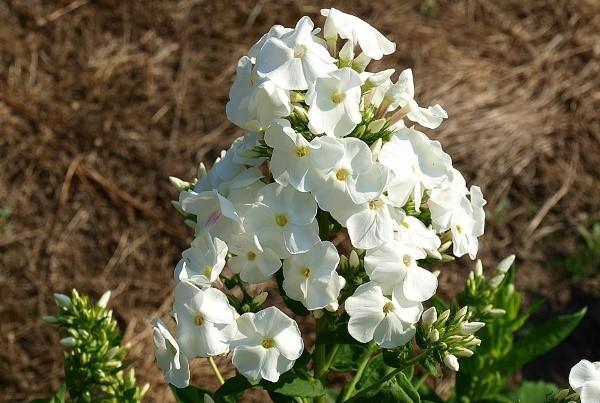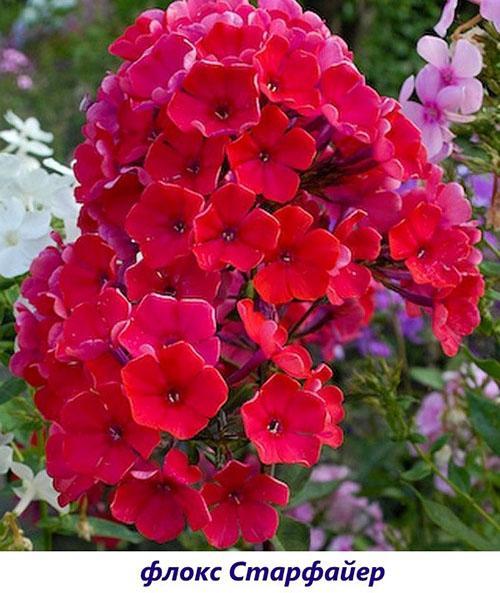Late blooming phloxes - an autumn decoration for your garden
 Late blooming phloxes are a real miracle of nature. At a time when most of the flowers in the flowerbed are living their last days, these beauties are just waking up. Some late varieties open their first buds in early August. Others bloom brightly in late summer. And there are also species that begin to bloom only in autumn, in September. So it turns out that you can admire such phlox right up to the very frost.
Late blooming phloxes are a real miracle of nature. At a time when most of the flowers in the flowerbed are living their last days, these beauties are just waking up. Some late varieties open their first buds in early August. Others bloom brightly in late summer. And there are also species that begin to bloom only in autumn, in September. So it turns out that you can admire such phlox right up to the very frost.
Late blooming phloxes are characterized by increased resistance, primarily to low temperatures. They winter well outdoors in almost any growing region. And diseases rarely damage bushes. As for the color, that is, among the late-flowering varieties, there are both gentle, light, tones, and rich, dark, colors. The sizes of the inflorescences and the flowers themselves are also varied. It can be both small-flowered inflorescences and lush brushes with large flowers.
Some of the brightest and most popular among late phlox flower growers include the following varieties:
- Viking;
- Starfire;
- Kirmeslander;
- Viy;
- Anniversary;
- Foster's red;
- Vladimir;
- New;
- Augustine;
- Guslyar.
Let's take a closer look at them and find out what plants look like when they bloom and what color they have.
Phlox Viking

The variety is resistant to frost and disease.
Phlox Starfire
 In the description of the phlox Starfire and in the photo, red color will prevail. First of all, this concerns its inflorescences: they are not very large, have a rounded-conical shape. But the color of the flowers immediately makes them stand out in the common flower bed. The dark red petals are slightly curled inward. They retain color saturation regardless of where they are planted. They bloom late, at the end of summer.
In the description of the phlox Starfire and in the photo, red color will prevail. First of all, this concerns its inflorescences: they are not very large, have a rounded-conical shape. But the color of the flowers immediately makes them stand out in the common flower bed. The dark red petals are slightly curled inward. They retain color saturation regardless of where they are planted. They bloom late, at the end of summer.
The bush itself is no less beautiful. Growing up to 80 cm, it perfectly keeps its shape thanks to its strong stems. By the way, their tops are also red, but darker like a cherry.
Starfire can cause breeding difficulties by dividing the bush. Often its lateral shoots, which are separated, do not have their own roots at all. When digging up, you need to capture the central root, and this threatens the destruction of the mother plant.
Phlox Kirmeslander
 One of the latest flowering varieties, it blooms only at the end of August, or even in September. The bush is tall, up to 1.2 m in height, with upright strong stems. The flowers are round, white, with a pink-red eye. The inflorescences are large, spherical, can hold up to 90 buds.
One of the latest flowering varieties, it blooms only at the end of August, or even in September. The bush is tall, up to 1.2 m in height, with upright strong stems. The flowers are round, white, with a pink-red eye. The inflorescences are large, spherical, can hold up to 90 buds.
Phlox Kirmeslander is one of the most persistent species. He winters well, almost does not get sick, is not sensitive to sudden changes in weather.
Phlox Wii
 A mid-late variety with a mysterious name will surprise you with huge branched inflorescences. The flowers are not very large, less than 4 cm in diameter, but there are many of them. Blooms in early August. The plant is rather tall, more than 1 m. Lilac tones prevail in color. The edges of the petals are darker; closer to the center, they brighten.A small crimson eye can be seen in the middle. Translucent purple rays radiate from it.
A mid-late variety with a mysterious name will surprise you with huge branched inflorescences. The flowers are not very large, less than 4 cm in diameter, but there are many of them. Blooms in early August. The plant is rather tall, more than 1 m. Lilac tones prevail in color. The edges of the petals are darker; closer to the center, they brighten.A small crimson eye can be seen in the middle. Translucent purple rays radiate from it.
The variety winters well, is not afraid of rains and dampness.
Phlox Jubilee
 It grows up to 80 cm in height, the bush is dense, with strong stems and dense foliage. The tops of the shoots are darker, almost brown. It blooms late, in August, with red inflorescences. They are slightly disheveled, in the shape of a tall pyramid. The flowers are large enough, almost 4 cm in diameter, do not fade. The variety is resistant to wet weather.
It grows up to 80 cm in height, the bush is dense, with strong stems and dense foliage. The tops of the shoots are darker, almost brown. It blooms late, in August, with red inflorescences. They are slightly disheveled, in the shape of a tall pyramid. The flowers are large enough, almost 4 cm in diameter, do not fade. The variety is resistant to wet weather.
In the cold summer, a light spot appears in the center of the flower, and the red color takes on a crimson hue.
Foster's red phlox
 As the name implies, this phlox also has a red color. It was bred by the famous breeder and gardener Karl Foster, thanks to whom it got its name. Besides late flowering, its color is very original. Flowers in partial shade are bright red, but in the sun they acquire an orange tint. Their shape is very interesting and beautiful. Each petal folds in the center and folds its edges inward. Thanks to this, the rounded inflorescence looks like a ball with red stars. Another plus is the height of the bush (up to 1.3 m), which additionally distinguishes phlox against the background of other plants.
As the name implies, this phlox also has a red color. It was bred by the famous breeder and gardener Karl Foster, thanks to whom it got its name. Besides late flowering, its color is very original. Flowers in partial shade are bright red, but in the sun they acquire an orange tint. Their shape is very interesting and beautiful. Each petal folds in the center and folds its edges inward. Thanks to this, the rounded inflorescence looks like a ball with red stars. Another plus is the height of the bush (up to 1.3 m), which additionally distinguishes phlox against the background of other plants.
Unfortunately, there is not so much information about this variety. Perhaps it has a completely different name, but among the phloxomaniacs it is called so - Foster's red phlox. Sometimes you can still find the name "late Foster".
Phlox Vladimir
 A romantic mid-late variety with a delicate coloration, flowers in August. Large, more than 5 cm in diameter, light pink flowers. In the center there is a small ring, one tone darker. The edges of dense petals are lighter, almost white (including at the base). The inflorescence is of medium size, but dense, conical in shape. The height of the bush does not exceed 70 cm, the stems are strong, do not fall apart.
A romantic mid-late variety with a delicate coloration, flowers in August. Large, more than 5 cm in diameter, light pink flowers. In the center there is a small ring, one tone darker. The edges of dense petals are lighter, almost white (including at the base). The inflorescence is of medium size, but dense, conical in shape. The height of the bush does not exceed 70 cm, the stems are strong, do not fall apart.
Phlox of the Vladimir variety grows and reproduces rapidly.
Phlox New
 According to the description of Novinka phlox, this variety is by no means new. Received back in 1952, it firmly holds its position in the hearts of phloxomaniacs. The compact bush keeps its shape well and does not exceed 75 cm in height. In August, lush large round-shaped inflorescences bloom. The flowers are very large, up to 4.3 cm in diameter. They are painted blue and white with a small purple ring inside. In the bud phase they are blue.
According to the description of Novinka phlox, this variety is by no means new. Received back in 1952, it firmly holds its position in the hearts of phloxomaniacs. The compact bush keeps its shape well and does not exceed 75 cm in height. In August, lush large round-shaped inflorescences bloom. The flowers are very large, up to 4.3 cm in diameter. They are painted blue and white with a small purple ring inside. In the bud phase they are blue.
The blueness of the petals fades in the sun, and white color begins to prevail.
Phlox Augustine
 The variety surprisingly combines the power of a tall bush and the charm of small flowers. Plant height reaches 1.1 m, strong shoots. The flowers are only 2.7 cm in diameter, but there are a lot of them. They are painted in a pale pink color with a purple ring inside. The inflorescence is large, pyramidal. The cultivar is medium late, but with a long flowering. Blooms in August and stands in buds until frost. Inflorescences bloom nearby in late autumn chrysanthemums and a beautiful duet is formed on the flowerbed.
The variety surprisingly combines the power of a tall bush and the charm of small flowers. Plant height reaches 1.1 m, strong shoots. The flowers are only 2.7 cm in diameter, but there are a lot of them. They are painted in a pale pink color with a purple ring inside. The inflorescence is large, pyramidal. The cultivar is medium late, but with a long flowering. Blooms in August and stands in buds until frost. Inflorescences bloom nearby in late autumn chrysanthemums and a beautiful duet is formed on the flowerbed.
Phlox Guslyar
 A compact variety with an average bush height of 60 cm, although there are also taller plants. Blooms in early August in large rounded inflorescences. The flowers themselves are quite large, the first buds can reach 4.7 cm in diameter. Subsequent flowers are not so impressive and are smaller up to 4 cm. Petals are slightly wavy. The color of the phlox is saturated, purple-crimson, in the center a darker small ring is barely visible. In the description of phlox Guslyar, it is indicated that the brightness of the color remains throughout the entire flowering period.
A compact variety with an average bush height of 60 cm, although there are also taller plants. Blooms in early August in large rounded inflorescences. The flowers themselves are quite large, the first buds can reach 4.7 cm in diameter. Subsequent flowers are not so impressive and are smaller up to 4 cm. Petals are slightly wavy. The color of the phlox is saturated, purple-crimson, in the center a darker small ring is barely visible. In the description of phlox Guslyar, it is indicated that the brightness of the color remains throughout the entire flowering period.
For some time the variety was known under the name Amethyst.
There are many more late flowering varieties, and there is a long list of them. Undoubtedly, these are the most coveted flowers that are often found in flower beds. Their lush and long flowering attracts attention precisely in the late periods. Plant late phlox in your plots and enjoy the gentle scent of the passing summer.